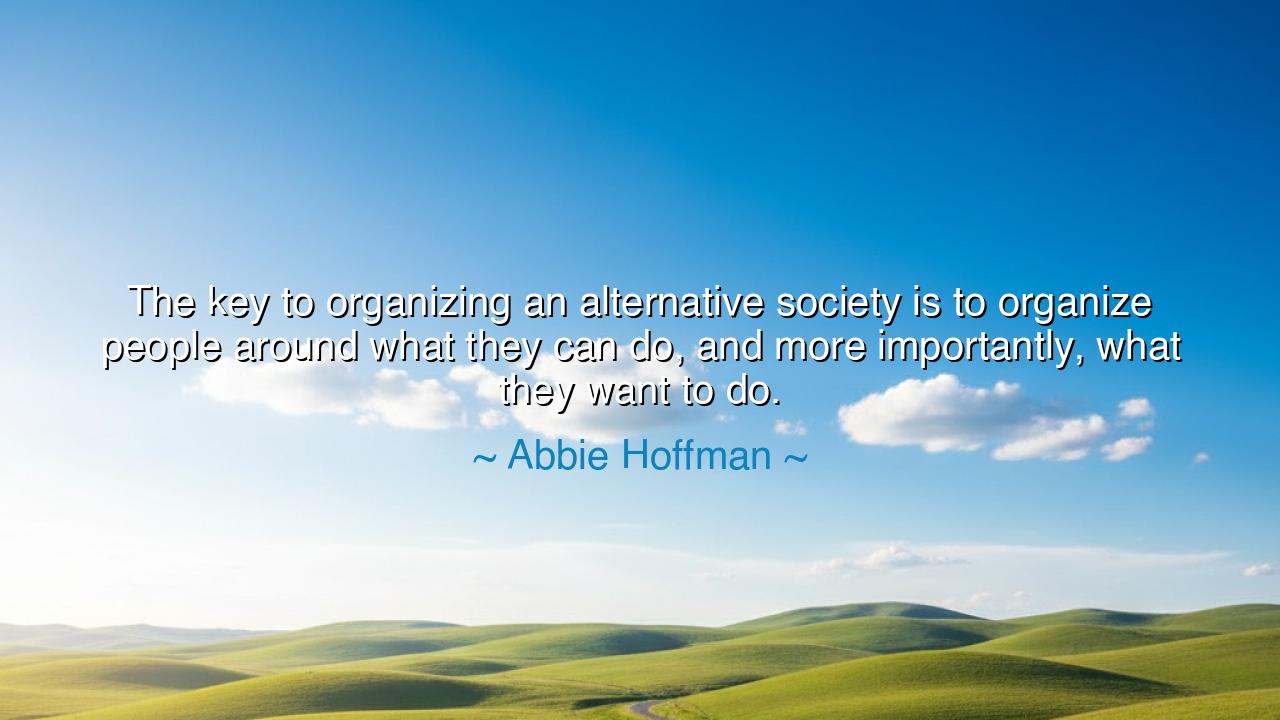
The key to organizing an alternative society is to organize
The key to organizing an alternative society is to organize people around what they can do, and more importantly, what they want to do.






Hear the fiery wisdom of Abbie Hoffman, who declared: “The key to organizing an alternative society is to organize people around what they can do, and more importantly, what they want to do.” In these words lies a lesson not only for rebels and visionaries, but for all who dream of a better world. For society is not merely built by laws, nor sustained by wealth, but by the labor and desire of its people. A community that forces men and women into duties they despise may survive for a time, but it will never thrive. True strength comes when each person’s abilities are honored, and their passions are given room to flourish.
The ancients, too, understood this. In the Republic, Plato spoke of harmony when each man and woman did the work best suited to their nature, whether soldier, craftsman, or philosopher. Confucius, in another land, taught that when a ruler aligns people with their gifts and inclinations, order and prosperity follow. Hoffman’s words are but a modern echo of these ancient truths: an alternative society—or indeed any just society—must not only demand labor, but must inspire people by giving them purpose aligned with both skill and desire.
Consider the story of the kibbutzim in Israel. In their earliest days, these communities were not built upon rigid hierarchies, but upon shared labor rooted in both ability and willingness. One taught, another farmed, another cooked, another healed. They were organized not simply by need, but by the strengths and desires of the individuals within them. In this way, they created vibrant communities, resilient and united, proving Hoffman’s vision: that people flourish when they do what they want to do as well as what they can do.
Contrast this with the failures of regimes that forced their people into labor without regard for passion or skill. In the Soviet Union, many were compelled to work in roles that suffocated creativity and ignored human longing. Production may have been achieved, but spirits were crushed, and innovation withered. A society may coerce bodies, but it cannot compel the soul to bloom. Hoffman’s teaching is a warning: an imposed order without joy will always decay from within.
The meaning runs deeper still. When people are gathered only around necessity, society becomes mechanical; but when they are gathered around desire and creativity, society becomes alive. A man who sings because he longs to sing gives more to the world than one who is ordered to make noise. A woman who teaches because she loves knowledge lights fires in young minds more brightly than one who is forced to lecture. Hoffman reminds us that desire is the wellspring of true contribution.
The lesson for us, O listener, is to ask not only what others can do, but what they love to do. Leaders, parents, teachers, organizers—learn the gifts of those entrusted to you, and honor their passions. Create communities where joy and work are bound together, where contribution flows not from coercion but from calling. For such a society will not merely survive; it will create, inspire, and endure.
Therefore, let Hoffman’s words echo as a command for builders of the future: “Organize people around what they can do, and more importantly, what they want to do.” In this lies the seed of freedom, of innovation, of harmony. A society built on desire and skill is a society that can withstand storms, for its people are not prisoners but creators.
And so, let this wisdom endure: the foundation of a better world is not in force but in freedom, not in compulsion but in creativity. Discover what men and women can do, nourish what they long to do, and in that union you will find the power to build a society that is not only functional, but beautiful.






AAdministratorAdministrator
Welcome, honored guests. Please leave a comment, we will respond soon